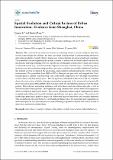Spatial evolution and critical factors of urban innovation: evidence from Shanghai, China
Author(s)
Li, Lingyue; Zhang, Xiaohu
Downloadsustainability-12-00938-v2.pdf (7.562Mb)
Publisher with Creative Commons License
Publisher with Creative Commons License
Creative Commons Attribution
Terms of use
Metadata
Show full item recordAbstract
The critical role of urban innovation in sustaining urban economic resilience has been widely acknowledged by scholars. Yet there is far from a full spectrum of understanding about how innovation performs, despite China’s innovation outputs having far outweighed most countries’. The perennial concern regarding the spatial patterns of innovation has been biased towards the macroscale, and long-standing efforts to explore the determinants of innovative vitality are focused on internal factors (e.g., research and development activities, and firm size). Considering these inadequacies, this research investigates how innovative activities are spatially distributed and how the pattern evolves in cities at the microscale, and examines influencing factors of the external environment. The patent data from 2000 to 2015 in Shanghai are geocoded and mapped into 1 km2 hexagon grids to identify local clustering. Gini coefficient is computed to show the high concentration of innovation activities across space. The hot spot analysis based on the Getis–Ord (Gi*) statistic shows that innovation exhibits a strong concentration propensity at the microscale and gradually moves toward a polycentric pattern. However, the extent of concentration decreases over the study period. Firms dictate innovation activities, and individuals and universities also play a role in downtown innovation growth. The regression using random effect model shows heterogeneous effects on different innovation actors. The overall urban innovation output, dominated by firms, is significantly influenced by public budget expenditures and green space areas. The science and technology grant has a positive impact on authorities but not university and research institutes. This research not only contributes to a methodological innovation for measuring and visualizing an innovation pattern but also enriches our understanding of spatial evolution and critical factors of innovation activities in urban China. Keywords: innovation; economic resilience; city; patent; spatial characteristics; influential factors
Date issued
2020-01-27Department
Massachusetts Institute of Technology. SENSEable City Laboratory; Massachusetts Institute of Technology. Department of Urban Studies and PlanningJournal
Sustainability
Publisher
Multidisciplinary Digital Publishing Institute
Citation
Li, Lingyue, and Xiaohu Zhang, "Spatial evolution and critical factors of urban innovation: evidence from Shanghai, China." Sustainability 12, 3 (Jan. 2020): no. 938 doi 10.3390/su12030938 ©2020 Author(s)
Version: Final published version
ISSN
2071-1050